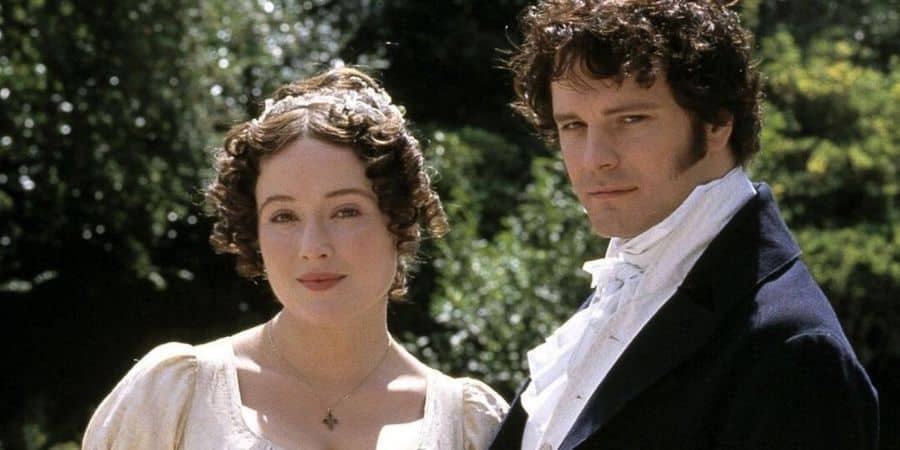Read an analysis of Pride and Prejudice
The opening sentence
Jane Austen began Pride and Prejudice with a sentence which, for the past two centuries, has been recognized as probably the best opening of any novel, and certainly one of the most famous:
“It is a truth universally acknowledged, that a single man in possession of a good fortune, must be in want of a wife.”
It is not without reason that it has achieved that status. It is almost as if Jane Austen did not need to continue writing the novel because that sentence does everything. It foreshadows the story to come and it introduces the hero. It states the main themes and it is a fine example of the prose technique we are about to enjoy, with its innovative use of point of view, something Jane Austen experiments with here, and perfects in her last published novel, Emma. And to top it all its ironic tone signals the delicious humour that keeps the reader chuckling from the beginning to the end.
Narrative technique: Point of view
Most commercial study guides for school students simplify complex literary phenomena by labelling different types of point of view. By that standard, the viewpoint in Pride and Prejudice is usually described as ‘third-person omniscient,” suggesting that what we have here is the authorial voice narrating the story.
However, although the story is narrated in the third person form there is no “omniscient” authorial voice. Everything the author narrates is from the perspective of one character or another, and although most of the time the reader is seeing the world through the eyes of Elizabeth Bennet, much of the irony and the humour comes from a commentary that reflects other points of view.
Using Elizabeth Bennet as the main point of view character is a trick. It allows the author to misdirect us, rather like a magician does, making us concentrate on the magician’s explanation of what he’s doing while he’s actually doing something else.
In the same way, we are drawn in by the character of Elizabeth and we identify with her early in the narrative. She interprets the society and the characters and events and we assume her judgments. But Elizabeth is making some serious misjudgements and mistakes, which we miss, because of our close identification with her, where we accept her judgments and share her misconceptions. She gets a lot of things wrong and so do we, so the revelations that come later are joyful surprises, which we experience at the same time as Elizabeth does. We share her opinion of Darcy as a cold, haughty man with no good qualities and come to our slow recognition of what he really is as, shut out from any other view of him, we follow her point of view and see him only as she does.
The “unreliable narrator” is a technique that is more or less an invention of Jane Austen’s, taken to a level of perfection in Emma. Novelists have subsequently used the device and in the 20th Century it became one of the central devices of postmodern writers. In Pride and Prejudice, we can already see the beginnings of the technique.
Jane Austen slips into and out of the heads of different characters, presenting a range of other viewpoints, disguised beneath the veneer of a third person narration. That allows her to reach depths which a third person omniscient authorial voice could never achieve.
In that opening sentence, “It is a truth universally acknowledged, that a single man in possession of a good fortune, must be in want of a wife,” it is not Jane Austen telling us a “fact’ with a straight face. It is far more than that. It is the gossipy opinion of the ladies with daughters who live in the neighbourhood. But considering the scene that immediately follows that sentence we can also say that we are in the mind of Mrs Bennet. The author’s position here is not to tell us anything “universal” about life but to make fun of Mrs Bennet, which Jane Austen continues to do throughout the novel, regardless of whose point of view she employs.
Such observations as “To be fond of dancing was a certain step towards falling in love,” although narrated in the third person, are not “facts” from the author: they are points of view.
There are several such instances of Jane Austen’s particular viewpoint technique. Another example is where we are first introduced to Mr Collins. Jane Austen narrates a brief history of the conditions and events that have led to his present position and it seems to be a straight account but it is a catalogue of reasons Collins mentally enumerates as he congratulates himself on where he has arrived in life. Once again, the reality beneath the author’s narration is that we are inside the head of one of the characters.
Other narrative techniques
Jane Austen experimented with narrative techniques and one of the ways in which she holds the reader’s attention so firmly is in always confronting the reader with variable perspectives, dramatic interplay, and both direct and indirect dialogue. The indirect dialogue is dialogue in the guise of narration. Here is a conversation between Elizabeth and Jane:
“She represented to her sister as forcibly as possible what she felt on the subject, and had soon the pleasure of seeing its happy effect. Jane’s temper was not desponding, and she was gradually led to hope, though the diffidence of affection sometimes overcame the hope, that Bingley would return to Netherfield and answer every wish of her heart.”
The conversation is contracted into a short paragraph but covers the words and the emotions of both sisters, and we can even hear their voices.
At times situations are depicted with broad generality and at another time from the restricted tunnel vision of one of the characters. Darcy’s first proposal of marriage is not a straightforward dialogue between them as one might have had in a play. It’s presented from Elizabeth’s point of view and Austen uses direct speech for that while recounting most of what Darcy says and comments on its effect on Elizabeth. His virtual silence suggests that he has been put off by her rejection. It is only later that Darcy’s voice comes out in his letter where we have him talking, uninterrupted, at length, and we discover what he was thinking during their conversation. And now we have moved a long way forward in our understanding of Darcy, of the situation, and of Elizabeth’s feelings towards him.
The less central characters’ voices are often heard as reported by the author, which allows for their being combined with irony and humour, unintended by the speaker, which is one of the ways in which we are made to laugh out loud at Mr Collins.
That’s our Pride and Prejudice analysis. Make sense? Any questions? Let us know in the comments section below!

Jennifer Ehle and Colin Firth as Elizabeth Bennet and Fitzwilliam Darcy in the BBC Pride and Prejudice adaptation




Leave a Reply
Want to join the discussion?Feel free to contribute!